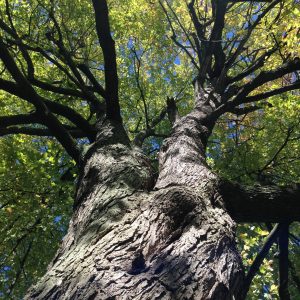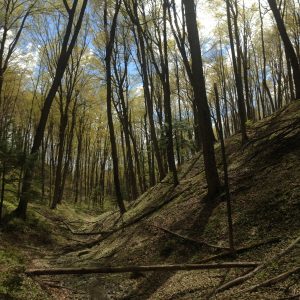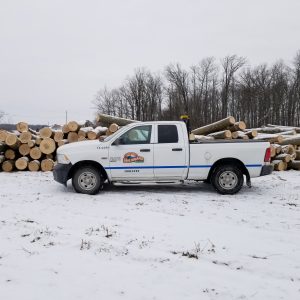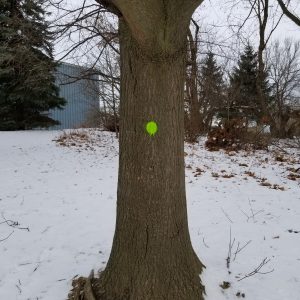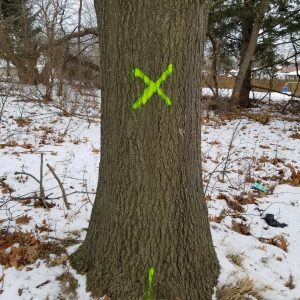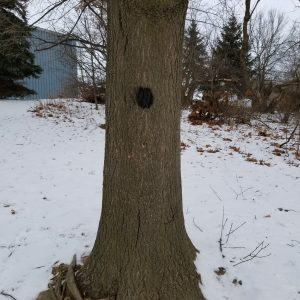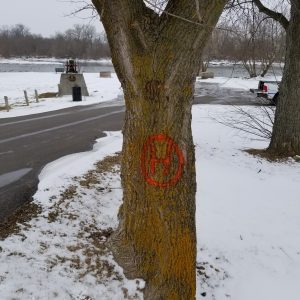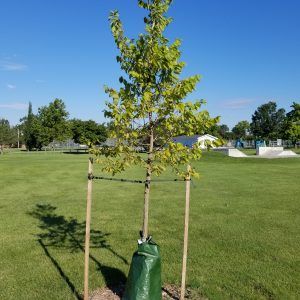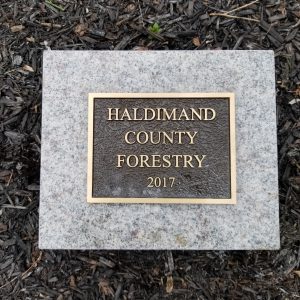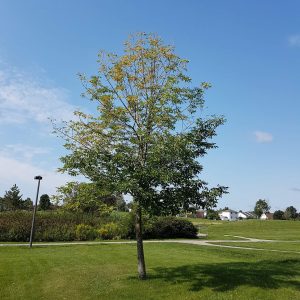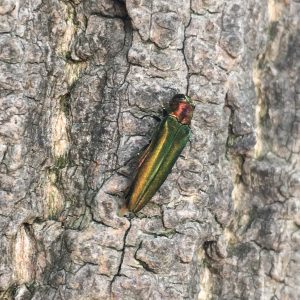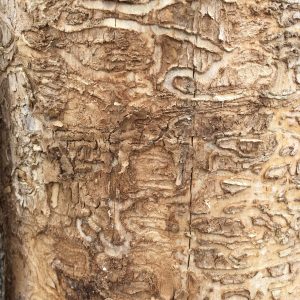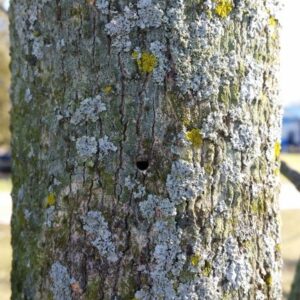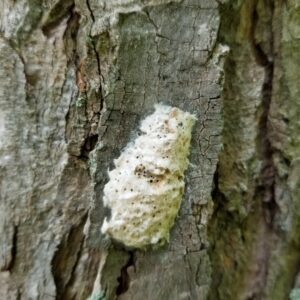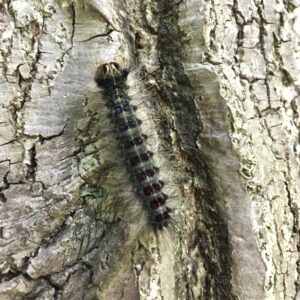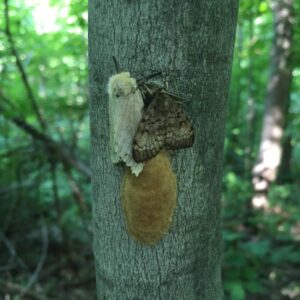If you’re looking for information about Trees & Forest Conservation, this is the place to find it. For any of your tree related needs, please have a look at our Frequently Asked Questions (FAQ) tab below or contact our Forestry division.
Trees & Forest Conservation
Forestry Services – Haldimand County Administration Building
53 Thorburn Street South, Cayuga ON N0A 1E0
Phone: (905) 318-5932, Ext. 6503
Email: forestry@haldimandcounty.on.ca
View information on Downtown Street Tree Revitalization Projects.
In 2016, Haldimand County adopted a Forest Strategy and Management Plan (2016 – 2026).
This plan outlines the vision and strategy for managing the County’s urban forests. It explains what actions need to be completed and when they need to be completed so that the County can sustainably manage and protect our urban forests for the social, environmental and economical benefits they provide to our community.
To find out more about the Forest Strategy and Management Plan for Haldimand County, please see the links below:
Haldimand County has a strong history of protecting its natural heritage resources through the use of forest conservation by-laws that have been in effect since 1981. Our forests on both public and private lands in Haldimand County provide many valuable economic, environmental and social benefits such as wildlife habitat, forest products, recreational activities, watershed protection, preventing soil erosion and mitigating the effects of climate change through carbon sequestration. The purpose of the by-law is to:
- Achieve the County’s Official Plan objective to preserve and improve Woodlands through the application of Good Forestry Practices;
- Encourage the production of wood, wood products and sustaining the local forest economy;
- Minimize the injury or destruction of trees in Woodlands; and
- Contribute to ecosystem health, human health, recreation, enjoyment and improving quality of life through the conservation of Woodlands.
You must have an approved permit before you can cut, injure, harvest, burn or destroy trees within Woodlands.
2204-20ForestConservationBylaw
Permits
Good Forestry Practices Permit
This permit is used when a landowner wants to sustainably harvest select trees within a Woodlands and can be approved by staff. A Good Forestry Practices application must include a Silvicultural Prescription prepared by a Qualified Ontario Professional Forestry Association (OPFA) member and the trees to be cut must be marked by a Ministry of Natural Resources and Forestry Certified Tree Marker.
20240820GoodForestryPracticesPermitApplication
20201015GuidelinesforGoodForestryPractices
Minor Exception Permit
This permit is used when a landowner wishes to clear-cut an area of Woodlands. A Minor Exception application impacting an area of Woodlands one (1) hectare or greater in size must include an Environmental Impact Study.
20240820MinorExceptionPermitApplication
20201001GuidelinesforMinorException
20201001GuidelinesforNormalFarmPractices.pdf
We’re here to help. For any questions relating to the Forest Conservation By-law, assistance with completing an application or to report the cutting of trees in a Woodlands please contact forestry@haldimandcounty.on.ca
Haldimand County values its tree canopy cover and the numerous economic, environmental and social benefits trees make to the health of our community. A County Tree By-law is one of the tools that the County uses to protect County-owned trees in our cemeteries, parks, County facilities, along trails and roads.
The objectives of the County Tree By-law are to:
- Protect County-owned trees from injury and destruction;
- Recover maintenance and replanting costs from individuals who wrongfully injure or destroy County-owned trees; and
- Provide a fair and transparent permitting process for residents needing to work around, prune or remove County-owned trees.
This by-law does not regulate any trees on private property.
20240820CountyTreePermitApplication
We’re here to help. For any questions relating to the County Tree By-law, assistance with completing an application or to report the cutting of County owned trees please contact forestry@haldimandcounty.on.ca
Residents are reminded that they are not permitted to plant, prune (trim) remove or injure trees located on County-owned property including cemeteries, facilities, parks, along roads and trails without prior approval from the County. If you have any questions or concerns about a County-owned tree please contact (905) 318-5932 ext. 6503 or forestry@haldimandcounty.on.ca. Forestry staff can assist you with:
- Determining if a street tree is located on County or private property
- Assessing the health and structural condition of a County-owned tree
- Maintaining County-owned trees through pruning, removal and stump grinding
- Planting new street trees on County property adjacent to your property
If there is an immediate emergency involving a fallen tree or broken branches blocking a roadway please contact Haldimand County Roads Operations (905) 318-5932 ext. 8601 (Monday to Friday, 8:30-4:30) or 1-888-849-7345 (after hours only).
Inspection and Marking
Forestry staff inspect County-owned trees on an as-requested basis to assess their health and structural condition.
Trees identified for maintenance by Haldimand County are marked with green paint.
- Green dot: prune.
- Grey dot: pruning work has been completed.
- Green ‘X’: remove.
- Green line on the stump: stump removal.
- Green ‘X’ and line may be combined for tree and stump removal.
- Green circle on grass: new tree to be planted.
Hydro One also uses paint to mark both County and private trees for maintenance near hydro lines.
- Green dot: Prune
- Red/orange ‘H’: Remove
Pruning
Certified Arborists under contract with the County perform essential pruning maintenance of County-owned trees on a seven-year cycle as shown in the County’s Tree Maintenance Map. Proper pruning helps to develop trees with strong structures that are more resilient to damage during storms, extend the tree’s life and reduce future maintenance costs.
Removal and Stump Grinding
Certified Arborists under contract with the County remove County-owned trees/stumps if they die or become a hazard to public safety on a seven-year cycle as shown in the County’s Tree Maintenance Map.
Stumps located within areas of maintained lawns are ground out and replaced with topsoil/grass seed the year following the removal of the tree. The County does not remove stumps within unmaintained or forested areas.
Planting
New trees are planted through resident requests and the County’s infill planting program where forestry staff identify suitable street tree planting locations within the urban boundaries of Caledonia, Cayuga, Dunnville, Hagersville, Jarvis and Townsend.
Highway 3 and Highway 6
The maintenance of trees located along Highway 3 and Highway 6 outside of the urban boundaries of Caledonia, Cayuga, Hagersville and Jarvis is the responsibility of the Ministry of Transportation (MTO). If you have questions or concerns about trees along Highway 3 or Highway 6 please contact MTO 519-873-4223.
Hydro One Tree Maintenance
Hydro One is responsible for pruning and removing trees located on both County and private property that may impact hydro transmission lines (typically running parallel to the road). Hydro One performs tree maintenance on an annual cycle.
- Pruning around service lines that run from the transmission line to a home is the responsibility of the tree owner.
- The County prunes County-owned trees to provide clearance around service lines on a seven-year cycle.
You can submit a tree maintenance request to Hydro One through your Hydro One myAccount, by phone at 1-800-664-9376 or by email at customercommunications@hydroone.com.
Trees are an important part of our natural and cultural landscape. Trees provide aesthetic value, reduce airborne pollution, enhance water quality, prevent soil erosion, provide wildlife habitat, provide cooler air temperatures in the summer and sequester carbon. Haldimand County recognizes these important benefits for our community and encourages planting trees and has four different tree planting programs.
Street Tree Planting
You can contact forestry staff to have a tree planted on public property (boulevard) in front or beside your house free of charge. Forestry staff will arrange a site meeting with you at your property to review the proposed planting location, select the type of tree species to be planted and identify any potential restrictions to tree planting such as conflicts with hydro lines, sewer lines, water lines, sight lines and available planting space. Suitable street tree species are listed in the Haldimand County Street Tree List.
Spring Planting (April-May)
Applications must be received before the end of December to be eligible to have tree(s) planted for the Spring planting season. Applications received after the end of December will be added to the next Spring planting season.
There are a limited number of trees are available each year and applicants will be selected based upon the most suitable sites for the species available. If you have had a tree planted on public property and it has died please contact the Forestry Division to have the old tree removed and a new tree planted.
New Subdivision Tree Planting
In newly constructed subdivisions, the developer or the builder is responsible for street tree planting. Developers are required to submit a street tree planting plan to Haldimand County for approval. The selection and placement of the trees in a new subdivision is based on Haldimand County’s specifications for tree planting and there is little room for requests by homeowners for specific trees.
Infill Tree Planting
Haldimand County engages in actively planting new trees on boulevards, in parks and cemeteries throughout the County. These trees are planted in areas that not managed by any adjacent landowners.
Commemorative Tree Planting
Planting a tree in a public park is a beautiful way to memorialise a loved one or commemorate a significant life event. Commemorative trees can only be planted in parks and include the installation of a plaque. Applicants may request a specific park location for their commemorative tree to be reviewed and approved by Haldimand County.
- Trees are 50mm Wire Basket, 6’-8’ tall, staked, tied, mulched, rodent guard and watering bag included.
- Plaques are 8” x 6” bronze mounted on light grey granite base. There is space for (3) lines of text a maximum of (22) characters per line.
Applications must be received by the end of December to be eligible to have the tree planted during the Spring planting season. Applications received after the end of December will be added to the next Spring planting season.
For current fees refer to the County’s user fee bylaw schedule F.
If you or County staff notice that the tree has died, or the plaque has been damaged or vandalized it will be replaced as soon as possible.
The Provincial Cemeteries Act prohibits scattering of ashes outside of a registered cemetery.
Attachment 1: Haldimand County Street Tree List
Emerald Ash Borer
Emerald Ash Borer (EAB) Agrilus planipennis is an emerald green beetle, native to Asia and has been introduced to North America and is causing widespread damage throughout Ontario. Emerald Ash Borer only attacks true ash trees with White Ash and Green Ash being the most common in Haldimand County. Mountain-ash and Prickly Ash are not true ash and are unaffected by Emerald Ash Borer.
Signs & Symptoms of Emerald Ash Borer
- Crown Dieback: severely attacked trees may exhibit crown dieback as the branches die from the top down. Leaves may wilt or turn yellow during the growing season.
- Bark Cracks: Vertical splits of 7-10cm are often present over larval galleries. These are often more noticeable on young trees that do not already have splits from growth-related expansion.
- Woodpeckers: Woodpeckers feed on the larvae under the bark. Look for increased Woodpecker feedings or sign of their probing under the bark.
- Exit holes: Once fully mature, the adult beetles emerge through exit holes they chew through the bark. These holes are distinctly “D” shaped and are 3.5-4mm across.
- Tunnels: Winding “S” shaped larval tunnels snake under the bark where the larvae bore channels. Removing the bark exposes larval sawdust filled galleries.
- Epicormic shoots: Epicormic shoots grow from the base of the tree or along the trunk when the tree is stressed and can be a symptoms of Emerald Ash Borer.
If you have an ash tree on your private property, contact a Certified Arborist to assess your tree’s health as soon as possible. If your tree is healthy, insecticides are available that can protect it from Emerald Ash Borer. If your tree is infested, a tree care professional can remove it before it becomes a hazard to your safety or property. If you have Ash trees in your Woodlot contact the Facilities and Parks Operations, Project Manager, Forestry to determine if an application is necessary before the trees are removed.
Insecticide treatments can only be administered by tree care professionals and are not available to the general public. The insecticide is injected into the tree using pressurized canisters. It must be applied at least every two years, and every year when Emerald Ash Borer infestation pressure is high (many trees nearby are infested). Insecticide treatments work best if trees are treated before they are infested or when the infestation is at an early stage. Signs or symptoms of Emerald Ash Borer infestation are often not visible until it’s too late to apply insecticide.
Spongy Moth
Spongy Moth, Lymantria dispar, is a small brown/gray colour moth that is native to Central/Southern Europe and North Africa. It was introduced to North America in the mid-1800s with the intention of establishing a commercial silk industry.
The Spongy Moth larvae (caterpillars) feed on primarily Oak species, however during population booms the larvae will also damage Maple, Alder, Birch, Hawthorn, Beech, Crabapple, Poplar, Cherry, Willow, Basswood and other species.
Spongy Moth populations follow a boom and bust cycle. Outbreaks usually last from one to five years and then subside due to starvation, predators and the presence of a naturally occurring soil-borne bacteria called Bacillus thuringiensi (Bt) which infects the larvae. Populations then remain low from four to twelve years before another outbreak cycle.
During years with low populations the feeding caused by the larvae is barley noticeable and healthy trees that are defoliated are able to grow new leaves and will recover the following year. Several years of heavy defoliation or defoliation combined with other stressors such as drought, root damage, poor growing conditions can cause too much stress and kill the trees.
Signs & Symptoms of Spongy Moth
- Egg Masses: female moths lay egg masses on tree bark, branches or other projected places. Egg masses are tan coloured and covered in hairs.
- Defoliation: signs start as small holes in the leaves, but as the larvae continue to grow they will consume the entire leaf.
Control
Haldimand County does not administer an aerial spray program for the control of Spongy Moth on public or private lands. If you are concerned about Spongy Moth on your private property, you can contact a Certified Pesticide Exterminator to inspect your trees.
For single trees or small groups tree the installation of sticky bands will catch the caterpillars as they move along the trunk of the trees. Pheromone traps can also be used to lure and trap male moths, preventing them from mating with female moths are another effective control.
For woodlands or large areas with a significant number of host tree species an aerial spray can be highly effective at reducing Spongy Moth populations in the local area, but won’t have a significant impact on populations outside of the control area. The chemical controls for Spongy Moth are comprised of a bacteria Bacillus thuringiensis (Bt) already found in the local environment that kills the Spongy Moth larvae quickly. No control method will ever completely eradicate the entire Spongy Moth population.
Oak Wilt
Oak Wilt (Bretzeilla fagacearum) is a fungal pathogen that causes infected trees to develop gums which restrict the follow of water and nutrients throughout the trees vascular system. Oak Wilt has not yet been confirmed in Canada, but it has been found in United States close to the Windsor border and it is only a matter of time before it spreads into Canada.
Oak will can infect and kill all species of Oak. Trees in the Red Oak group (Red Oak, Black Oak, and Pin Oak) are the most susceptible and can be killed in as little as two to six weeks. Trees in the White Oak group (White Oak and Bur Oak) are more resilient and it usually takes one to two years before the tree dies.
Oak Wilt spreads through root grafts where Oak trees are growing close to each other and through spores that are carried by nitidulid beetles when they feed on an infected tree and then fly to a healthy tree.
Signs and Symptoms of Oak Wilt
- Leaf Discolouration: Leaves appear lighter in colour, yellow or brown.
- Wilting Leaves: Wilting or browning of the leaves starting at the top of the tree and branch tips. Symptoms start to develop beginning in May and over the growing season.
- Early Leaf Drop: Leaves start falling off the tree in the summer or earlier in the fall.
- Pressure Pads: Fungal mats develop under the bark which can raise or split the bark. Fungal mats will develop a “fruity” smell.
Control
There is currently no cure available for Oaks infected with Oak Wilt. The best approach is to monitor for signs/symptoms of the disease and reduce the risk of trees becoming infected.
- Do not move firewood or other wood products.
- Avoid pruning or removing Oak trees from March to September when the fungus is most active.
- If a pruning or removing an Oak tree when the fungus is active, cover the entire exposed area of the pruning cut or stump with paint to prevent fungus from being able to enter the tree.
- If you think a tree has Oak Wilt report it to the Canadian Food Inspection Agency.
Hemlock Woolly Adelgid
Hemlock Woolly Adelgid (Adelges tsugae) is an aphid-like insect that live on Hemlock trees and forms white sacs at the base of their needles. They feed on the tree cells responsible for storing the nutrient and water supply. Infestations can kill a healthy Hemlock in four to fifteen years.
Hemlock Woolly Adelgid is established in several states and has been found in southwestern Nova Scotia. Particularly concerning to Haldimand County, are two small populations of Hemlock Woolly Adelgid detected near Wainfleet and Niagara Falls in 2019.
Hemlock Woolly Adelgid is most commonly spread by wind, birds, and deer, but it can also be spread through the movement of firewood and wood products.
Signs and Symptons of Hemlock Woolly Adelgid
- White Sacs: Look for small white sacs at the base of the needles.
- Crown Dieback: Buds and small branches dieback and some may break off the tree.
- Premature needle loss: Needles may begin to drop early in the season.
- Foliage discolouration: The needles may turn a greyish green colour rather than healthy shiny, dark green.
Control
- Monitor Hemlock trees for white sacs on the underside and tips of the branches.
- Do not hang birds feeders on Hemlock trees or trees in the surrounding area.
- Do not move firewood or wood products.
- Hemlock Woolley Adelgid is federally regulated by the Canadian Food Inspection Agency (CFIA), which continues to monitor current populations. If you think a tree is infested with Hemlock Woolly Adelgid report it to the Canadian Food Inspection Agency.
Who do I contact for pruning or removal of a public tree in the right-of-way?
Please contact our Forestry division. A Certified Arborist will inspect the tree and will provide recommendations regarding any required tree maintenance. Applicants will be notified with the results of the inspection and if any maintenance will be scheduled for the tree.
How do I know if the tree in front of my house is on public property or private property?
Please contact our Forestry division and staff will inspect the tree to determine if your tree is on public or private property.
Can I trim or remove the public tree in front of my house?
No, only Haldimand County staff and Certified Arborists hired by Haldimand County can perform maintenance on public trees. If you have a concern with a public tree, please contact our Forestry division.
My neighbour has a private tree that is causing problems for us. Can the County do anything about it?
If there are dead, decayed, damaged or hazardous trees located on private property then you can report your concerns to a County by-law officer. The officer may issue an order to the owner of the tree to correct the hazard, if the tree is not in compliance with the County’s Property Standards By-law 730/06.
The removal or trimming of healthy, structurally sound and non-hazardous private trees is a civil matter between yourself and neighboring parties.
The public tree in front of my house has a bee/wasp/hornet nest in it. Will the County remove it?
Please contact our Forestry division to request an inspection. As these insects are beneficial to our ecosystem, staff will determine if the nest threatens public safety and arrange for removal if required.
What do the signs/markings on public trees mean?
A public tree that has been scheduled for removal or pruning by Haldimand County will be marked with green paint.
Other companies such as Hydro One may mark public trees for their maintenance operations. Also public trees may have the signs moved or vandalized or other marks may be added to the tree, so just because a tree is marked, it doesn’t always mean that Haldimand County will be performing maintenance on the tree. If you have a specific inquiry about a tree, please contact our Forestry division.
Who do I call to get a public tree inspected?
Please contact our Forestry division. A Certified Arborist will inspect the tree and will provide recommendations for required tree maintenance. You will be contacted with the inspection results including any maintenance to be scheduled for the tree.
Do I need a permit to cut trees in my woodland? Who do I call if I have a concern or question about woodlands being cleared on private property?
Woodlands are regulated by the Forest Conservation By-law. You must submit either a Good Forestry Practices application or Minor Exception application and receive a permit from Haldimand County prior to the removal or clearing of trees. Please contact our Forestry division for more information or if you see any clearing of woodlands.
When will the public tree on my boulevard be pruned or removed?
To date, Haldimand County has documented over 18,000 public trees along Haldimand County roads, in parks and cemeteries. It takes time to complete all of the work required for such a large population of trees. To ensure that the tree maintenance in Haldimand County is completed efficiently, once a tree has been recommended for maintenance by a Certified Arborist, a work order is generated and the tree maintenance is done on a priority basis that is evaluated based on the condition, location and risk the tree presents to public health and safety.
A public tree was cut down in the boulevard, when will the stump be removed?
Removal and stump grinding maintenance is typically completed the year after the removal of the tree, in the summer and/or fall.
Why won’t the County cut down the tree in the boulevard?
Trees provide many important benefits for the community. To maintain these community benefits, only public trees that have been inspected and approved by a Certified Arborist will be removed.
Can I get a tree planted in the boulevard?
Yes! Haldimand County will plant a tree on the publicly owned boulevard in front or beside your house as long as there is suitable space based on Haldimand County planting standards.
What types of trees will Haldimand County plant on the boulevard and do I get to choose which species of tree will be planted?
Haldimand County has a list of approved street tree species suitable for the challenging growing conditions found in boulevards. Forestry staff will meet with you at your property to assess the conditions and make recommendations on the best tree for the boulevard. Tree species that are not suitable will not be planted. Please contact our Forestry division to request a tree.
Can I plant my own tree on the boulevard?
No, only Haldimand County staff and contractors hired by Haldimand County can plant trees on public boulevards. You can plant your own tree in front of your house as long as it is planted on your private property.
What if there isn’t space to plant a tree, can I still have one planted on my property?
Haldimand County will only plant trees on public property based on our planting standards. These standards ensure that the growth of the tree will not affect public safety or other infrastructure. If there isn’t enough space on the boulevard in front of your house, the tree will be planted at another suitable location on public property.
A Business Approach to Rural Property
Backyard Maple Syrup Production
Buffers Protect The Environment
Building Nesting Platforms For Ospreys
Careful Handling And Planting Of Nursery Stock
Caring For Ice Damaged Woodlots And Plantations
Cavity Trees Are Refuges For Wildlife
Choosing A Silvicultural System
Clearing The Way Preparing The Site For Tree Planting
Conserving The Forest Interior A Threatened Wildlife Habitat
Cover Crops Help Tree Seedlings Beat Weed Competition
Forest Conservation Bylaws in Ontario
Forest History In Eastern Ontario
Forestry Talk A Glossary Of Common Terms
Designing And Caring For Windbreaks
Preserving And Restoring Natural Shorelines
Promoting a Healthy Forest Through Tree Marking
Protecting Fish Habitat From Sediment
Protecting Trees From Vole Damage
Maintaining Healthy Urban Trees
Management Options For Abandoned Farm Fields
Managing Regeneration In Conifer Plantations To Restore A Mixed Hardwood Forest
Managing Young Hardwood Stands For Sawlog Production
Mulches Help Trees Beat Weed Competition
Naturalizing Your Local Park or Backyard
Options For Controlling Beaver On Private Lands
Planning To Establish A Forest In Open Fields
Planting and Caring for Nut Trees
Tree Shelters Help Hardwood Trees Grow Faster
Using A Back Pack Herbicide Sprayer To Control Weeds
Restoring Old Growth Features To Managed Forests In Southern Ontario
Restoring Shorelines With Willows
Room To Grow Controlling The Competition
Successful Transplanting Of Woodland Vegetation
The Old Growth Forests Of Southern Ontario
Tree Guards Protect Your Trees
Forestry and urban forestry resource documents.


